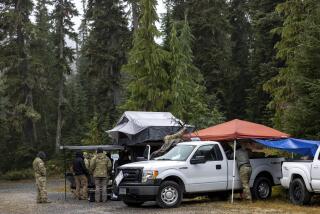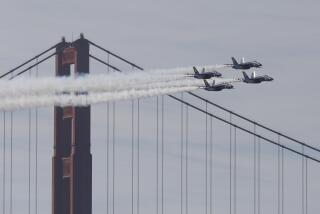Elite Female Navigators Quietly Made WAVES
- Share via
Behind the U.S. Navy’s World War II flyboys was a small band of women whose wing-and-a-prayer contribution to the war effort never made history books.
Almost 60 years ago, an elite group of WAVES--Women Accepted in Volunteer Emergency Services--charted a new course in air navigation and opened doors for other women into a male-dominated branch of the service.
These were the women--80 airborne, hundreds more on the ground--who served as stateside navigators, training male pilots in navigational skills and sometimes even riding shotgun on domestic military flights. They were the forebears of the Navy women who today fly as “top gun” pilots.
The Japanese bombing of Pearl Harbor on Dec. 7, 1941, ignited a war in the Pacific that changed the world. It also brought to Los Angeles’ Terminal Island a new kind of Navy navigator.
To free up men to serve at sea, thousands of women joined the Navy in the newly organized women’s unit called WAVES, and a few thousand more enlisted in the Coast Guard’s new SPAR women’s units, short for Semper Paratus, “Always Ready.”
Of those, 25,000 WAVES and 1,900 SPARs became part of naval aviation in jobs as mechanics, air traffic controllers, and radio and air navigators. About 200 of them worked at Terminal Island.
Only 80 female navigators, some of whom were already private pilots, were sent for further training: 50 flight hours in twin-engine military planes. That earned them prized gold wings as the nation’s first female military personnel to share noncombat flight duties with men.
Before World War II, only wartime emergencies brought women into military work, and then only in a limited capacity. Female volunteers had participated in every war involving American men, and formalizing their participation started to take shape in 1901 and 1908 with creation of the Army and Navy nurse corps.
In 1942, things changed. Joy Bright Hancock, a civilian pilot who had been a Navy yeoman in World War I, pressured the government to create the Navy WAVES and open up the field of navigation and related jobs to women, both on the ground and in the air.
Hancock was later promoted to captain and named director of the WAVES, making her the highest-ranking Navy woman, a distinction she retained for years.
To boost enlistments among women, Eleanor Roosevelt arranged for the American-born couturier Mainbocher--birth name Main Rousseau Bocher--to design uniforms for WAVES and SPARs. His prior experience included introducing the strapless evening dress in 1934.
In 1943, Marian Davis Skidmore and Marjorie Law Beringer were 21-year-old UCLA graduates when they and six other women joined the Navy and then, in Navy uniform, became the first female radio navigators assigned to Reeves Field, a military airfield on Terminal Island.
Skidmore and Beringer had just finished naval boot camp at New York City’s Hunter College, where they earned high marks in math and were among the first women selected to attend the Naval Air Navigation School in Atlanta. The 10-week radio navigation course--known as “coming in on the beam”--was tough. Those who did not maintain a 3.2 average were tossed out of the school. Trainees studied meteorology, drew weather maps, learned temperature drops and forecasts. They navigated and charted hypothetical four-hour flights over the Pacific, learned Morse code and how to use basic instruments such as a compass, altimeter, tachometer and turn-and-back indicators.
They wangled sea duty in the Pacific, Skidmore recalled sardonically--which meant “riding the San Pedro Ferry back and forth across the harbor” to a “glamour hot spot” on Terminal Island, “the best duty of any WAVES radio navigators.”
Reeves Field was known as the “Hollywood Country Club” because its wartime residents included such actors as Robert Taylor and Charles “Buddy” Rogers, who was married to Mary Pickford, as well as actress Norma Shearer’s husband, ski instructor and Navy aviator Lt. Martin Arrouge.
Since wartime gas rationing limited driving, Rogers rode a motorcycle to the field, while Skidmore and the others hopped on the Pacific Electric trolley downtown for the ride to San Pedro.
WAVES seldom had to walk the last mile from the drop-off point to the gate. If Marines patrolling the area in Jeeps didn’t happen by to give them a ride, they took a four-bit taxi ride, piling in eight to a car, WAVES sitting on sailors’ laps.
Terminal Island was one of the first islands seized from Japanese American fishermen and cannery workers shortly after Pearl Harbor was attacked. Its commander was Capt. Kneflar “Socko” McGinnis, who had won the Navy Cross for transporting the first mass flight of seaplanes from Northern California to Hawaii.
“He ran a good station,” recalled Skidmore, who along with Beringer still lives in Rancho Palos Verdes, not far from their old posting. “He was strict but fair, and you always knew where you stood with him. If men showed up for inspection in tailor-made uniforms they’d purchased in the Far East [with silk jacket linings, zippers and tight-fitting pants] instead of their GI-issue uniform, McGinnis had the tailor-made clothes collected and burned.”
Day and night, hundreds of new planes roared in and out of Reeves Field, one of the busiest naval ferrying air stations on the West Coast. Planes just off assembly lines were flight-tested and then “pickled” with a protective coating against the salt air before they were shipped to the South Pacific.
But not all went smoothly. Seasoned pilots who had served in the South Pacific and were now assigned stateside, and pilots too old for overseas assignments, resented having to learn radio navigation procedures from WAVES. They especially objected to WAVES evaluating their flying skills.
One of the 80 airborne WAVES, Betty Turbiville, was navigating on a training mission over the Pacific. The young male navigator she was teaching insisted that his charts were right. If the pilot had listened to him rather than to Turbiville, the plane would have run out of fuel and crashed in Mexico.
“I didn’t have anyone insult me for being in the service,” Skidmore said. “But once a pilot unfairly reported one of the WAVES who was bowlegged for not keeping her stocking seams straight.”
While the pilot in training sat in a mock-up training cockpit wearing a headset, Skidmore sat at a desk just outside, also wearing a headset, sending Morse code signals to the pilot, changing wind speeds and charting his path on a map to see how well he could follow the course changes. She reckons she trained hundreds of naval navigators this way.
On March 30, 1945, as the war neared its end, the Navy authorized a distinctive gold wings insignia for the 80 airborne female navigators, all of whom until then had worn a 1920s-design “observer” wing with a compass in the center over crossed anchors.
In their purses, these women carried copies of their orders authorizing them to wear wings, because they were often stopped by senior officers who pointed out that they weren’t allowed to wear their boyfriends’ wings.
Reeves Field was decommissioned in 1947 and eventually swallowed up by harbor development.
In 1948, all women on active military duty, including WAVES, were made an official part of the armed forces under the Women’s Armed Services Integration Act. Even so, women had to wait until 1967 for the removal of restrictions on the rank that even career military women could achieve.
Celebrating the contributions these women made to the war effort and commemorating their 60th anniversary, the Los Angeles Maritime Museum in San Pedro recently opened its newest exhibit, “WAVES and SPARS: Navy and Coast Guard Women of World War II.”
The show, which runs through July, chronicles an extraordinary group of women, some of whom earned the much-coveted U.S. Navy aerial navigator’s wings despite sentiments expressed by some enlisted men that it would take “two women to do the work of one man.”
Women’s contributions were noted contemporaneously as well. In 1944, the Navy estimated that the number of WAVES on duty that year equaled the number of men it would have taken in peacetime to man 10 battleships, 10 aircraft carriers, 28 cruisers and 50 destroyers.
More to Read
Sign up for Essential California
The most important California stories and recommendations in your inbox every morning.
You may occasionally receive promotional content from the Los Angeles Times.













